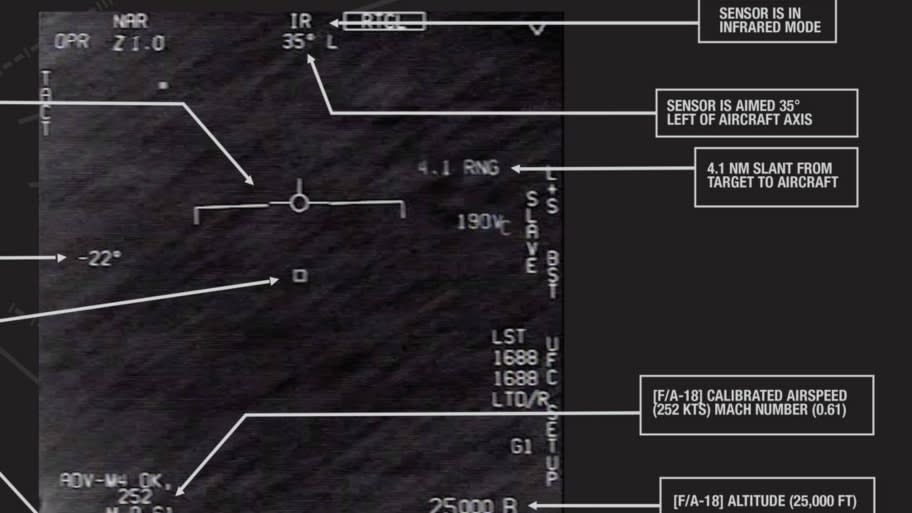So You Think You Found Aliens. Now What?

- Oops!Something went wrong.Please try again later.
There’s a growing consensus in the scientific community that there’s alien life out there, somewhere, in some form or another. It’s only a matter of time and scientific rigor before we find it.
If this summer’s spasm of excitement over “UFO sightings” is any indication, the public is primed to run with any evidence, however thin, that we’re not alone in the universe. Even if our extraterrestrial company is merely some microbe, living or long-dead.
Anticipating mounting evidence of alien life, and also anticipating that the media might mischaracterize that evidence, NASA’s good-natured chief scientist wants to put some guardrails on the story—by placing potential evidence of alien life on a seven-step scale that ranges from interesting to definitive.
In a paper published in Nature on October 27, NASA’s James Green proposed what he described as a “framework for reporting evidence for life beyond Earth”—a plan for how to confirm whether we've really found aliens.
“Our generation could realistically be the one to discover evidence of life beyond Earth,” Green wrote. “With this privileged potential comes responsibility. The magnitude of the question of whether we are alone in the universe, and the public interest therein, opens the possibility that results may be taken to imply more than the observations support, or than the observers intend.”
The Mystery Behind a Nearby Alien Beacon Is Solved
Imagine, for example, that NASA’s Europa Clipper probe—which is due to launch in 2024 on a mission looking for signs of life on Jupiter’s moon Europa—detects possible fleeting evidence of organic molecules under that world’s icy shell. “How do you announce that?” Seth Shostak, an astronomer with the California-based SETI Institute, told The Daily Beast. (SETI stands for the “search for extraterrestrial intelligence.”)
Scientists might contain their excitement while they await confirmation via follow-up missions. But the media might not be so prudent, Shostak warned. “You can be sure the press at the checkout line will be announcing, ‘Life on Europa!’”
Green wants to contain any undue enthusiasm. His framework “will disappoint anyone who expects first contact to replicate a Hollywood sci-fi blockbuster,” Douglas Vakoch, who heads METI International, a research organization in San Francisco that seeks to communicate with intelligent extraterrestrials, told The Daily Beast.
The framework is a ladder to evaluate evidence, with seven rungs. At the bottom rung: “detection of a signal known to result from a biological activity.” Perhaps microbes eating and excreting in a relatively hospitable extraterrestrial environment produce a gas that a probe like Clipper can observe. Some circles of scientists think that’s a possibility on worlds like Venus, Europa, and Saturn’s moon Enceladus.
The rung at the top of the ladder calls for “independent, follow-up observations of predicted biological behavior in the environment.” That essentially means different agencies have sent more than one specialized probe to follow up on sketchy initial signs of life—and they have confirmed it. Unequivocally.
Green said he hopes journalists—and scientists, for that matter—will withhold their celebration until we climb all the way to the seventh rung. “We recognize that the public would really like a yes or no answer,” he told The Daily Beast. But it’s important, as it he put it, not to put the first-contact cart before the evidentiary horse.
Ideally, these guardrails can temper the excitement of discovery and ensure no one announces we’re not alone in the universe until we’re really, really sure of it. “These measurements are important to help both journalists and scientists contextualize results,” said Green.
After all, some journalists most definitely did not “contextualize results” this summer when the U.S. Navy revealed that its pilots in the last 15 years or so had logged nearly 150 close encounters with what the service calls “unidentified aerial phenomena,” or UAP.
The U.S. intelligence community noted that most of these UAP were probably physical objects, given that they were registered across a slew of different instruments like radar, weapons seekers, and even through visual observations.
But military and spy agencies declined to say with any certainty what kind of physical objects the UAP might be. The possible categories include “airborne clutter, natural atmospheric phenomena, [U.S. government] or U.S. industry developmental programs, foreign adversary systems and a catchall ‘other’ bin.”
If the UAP are aliens taking joyrides in close proximity to Navy jets, they’re in that “other” category. But serious astrobiologists and experts who are involved in SETI research have dismissed the idea.

A still from a video released by the Department showing U.S. Navy pilots encountering a UAP.
“The amount of energy it would take to travel the interstellar void is enormous,” Michael Varnum, an Arizona State University psychologist who studies possible first-contact scenarios, told The Daily Beast. “You’d do all that to visit the Navy every few weeks?”
It’s not that good scientists don’t believe alien life might be out there somewhere. They just demand more evidence than a few feverish sightings by adrenaline-addled fighter pilots.
“Instead of declassifying documents that reflect decades-old technologies used by witnesses with no scientific expertise, it would be far better to deploy state-of-the-art recording devices, such as wide-field cameras on telescopes or audio sensors, at the sites where the reports came from and search for unusual signals,” Avi Loeb, a Harvard physicist, told The Daily Beast.
It’s that rigorous, state-of-the-art approach Green is championing. He wants the media to internalize the same expectations. That’s more important than ever, Wade Roush, a science lecturer and author of Extraterrestrials, told The Daily Beast.
“Thanks to the wave of misinformation and misunderstanding around the coronavirus pandemic, it’s clearer than ever that the general public's understanding of the scientific process is vague,” Roush said. “I think what Green and his co-authors are trying to do is coach their colleagues on how to talk about the uncertainties that are always baked into scientific results.”
“On top of all that, distrust in science, stoked by certain political leaders, is at a high point,” Roush added. “Green and the astrobiology community are aware that even one more mishandled, premature or misrepresented report of life elsewhere could sink the whole field's credibility.”
Asked if he’s hopeful any reporters will consult his framework, Green demurred. “Only time will tell.”
It’s worth noting that, around five years ago, a bunch of SETI experts—including Shostak—tried to craft their own evidentiary guidelines for the media’s benefit. SETI involves a lot of listening for faint radio signals from deep space that might originate with some far-away, possibly long-dead civilization. There are plenty of weird signals that seem like something tantalizing at first. Under further scrutiny, they turn out to be nothing but space noise.
But there are more than a few writers who are eager—too eager, perhaps—to report every stray signal as possible proof of alien societies in deep space.
Shostak and his colleagues’ efforts to rein in the sensationalist press went nowhere. “They just weren’t interested,” he said. It’s not clear yet whether the press might be more amenable to listening to Green.
Got a tip? Send it to The Daily Beast here
Get our top stories in your inbox every day. Sign up now!
Daily Beast Membership: Beast Inside goes deeper on the stories that matter to you. Learn more.

